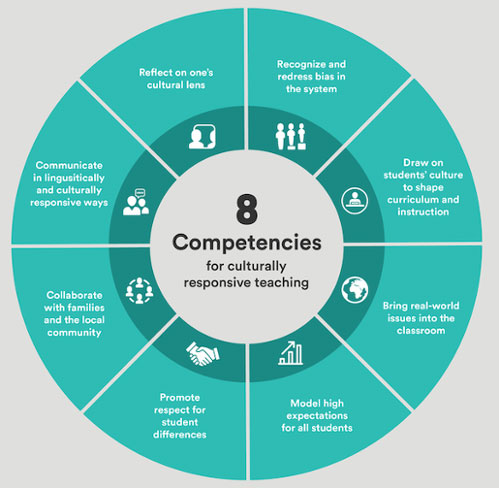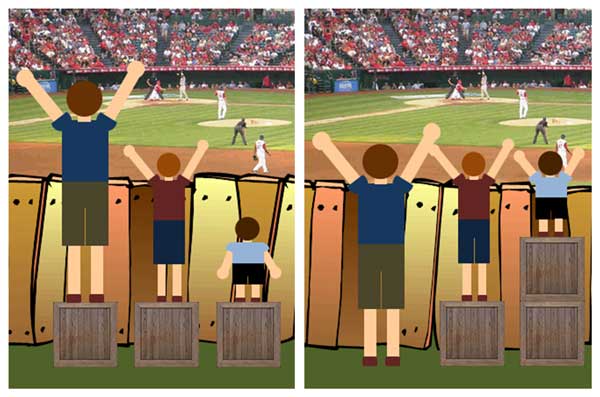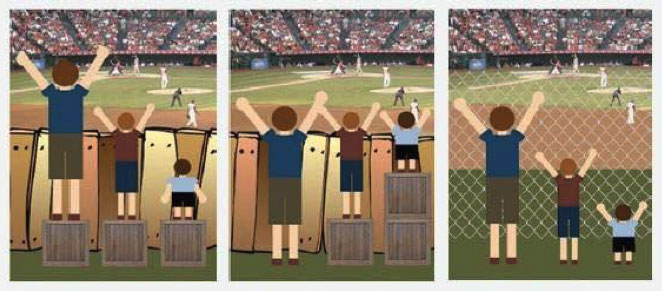Who needs inclusive teaching practices?
Individuals who feel like they are part of the collective, and are valued for their uniqueness within it, have more impact in group work, collective learning, and in the workplace. Students (and instructors) who cultivate a sense of belonging can avoid detrimental emotional and cognitive repercussions1 in their educational pursuits. Instructors who plan for inclusive and culturally responsive teaching are putting in place the systems that will help them respond to differences in the classroom. Culturally responsive teaching (not to be confused with critical race theory) helps educators consider the competencies needed to support all students.

Eight Competencies for Culturally Responsive Teaching by New America shared under Creative Commons Attribution 4.0 International license https://www.newamerica.org/education-policy/policy-papers/culturally-responsive-teaching-competencies/
Strategies for inclusion and responsive teaching
Building community with norms
We can build a community of learners by showing students that who they are matters to their learning. Community can be built by getting students to develop collective norms that reflect who they are. Norms that would be found in a syllabus are a good place to invite students to have input in the course. Most students have already experienced 10+ years of learning in schools and classrooms - they have some ideas of what works and what doesn't, so ask them! Having conversations and discussions about academic integrity, how work should be submitted, how weighting for course objectives was chosen, shows students that you have put thought into designing your course and that their views are valued too.
Knowing your students
Who are your students? We sometimes see our students as a sea of faces that are often 'masking' the students' emotional and lived realities. Here are some questions that can be used to get to know the student behind the 'mask'. Instructors might share a list of questions with students and ask them to pick one question to answer via email or discussion board. Or they could ask an elbow-buddy in class one of these questions. Try to offer choices and options for students to answer and how they need to respond. This should not cause undue stress.
- Describe what the term "family" means to you.
- When you talk about your family, whom does that include?
- Were you brought up in a community of people who look like you?
- Why did you choose the work you are doing now or are planning to do?
- Is this work similar to the work of your parents or grandparents?
- Does your culture of origin have special forms of address or titles for people who are older, have higher status, or special professions?
- How close or distant do you like people to be when next to you?
- What does eye contact mean to you?
- How do you react if you are late? If someone else is late?
- Do you feel that time is plentiful or scarce?
These questions are used with permission from Sarah Apedaile at Norquest College2.
Letting students know you
Just as you also have students share themselves with you, offering a bit about who you are can help your students understand the decisions you make and how you position yourself. This can effectively be done by sharing small anecdotes of experience in your discipline and stories from your own academic pursuits.
Having plans (and what to do when plans change)
As you start to prepare for teaching next term, it is helpful to develop a timeline of the term and think about how you will connect with students and how students will engage with each other at each stage (week, day, month). What do you expect as behaviours from students? What will you do if students don't meet expectations? Having flexibility and anticipating the needs of students is a useful exercise in the planning stages of course design.
Universal Design for Learning (UDL)
The image below describes the idea that when everyone is allocated the same resources (the boxes in the metaphor), some people manage to see over the fence just fine while others struggle. If the resources (the boxes) are distributed where they are needed such that everyone can see over the fence, then everyone has the opportunity to participate in the experience of watching the game. In our classes, what are the fences or barriers to participation? What are the tools or supports necessary for all students to see over the fence? This picture has been adapted and modified by many.
 Image from creator's webpost with permission3
Image from creator's webpost with permission3
A more recent adaptation removes the wooden fence and replaces it with a chain-link fence so that none of the students need a box (additional resources). Universal design tries to eliminate the fence and put in place structures or supports for all students to succeed.
 Image found at https://www.businessdisabilityinternational.org/when-is-equality-not-equality/ (creator not identified)
Image found at https://www.businessdisabilityinternational.org/when-is-equality-not-equality/ (creator not identified)
What can I do to respond to the variability in my classroom? How can I make a positive impact on the learning experience and move my course towards greater inclusivity and accessibility?
Click here for strategies and approaches you can integrate into your classroom:
Key terms
Human Dignity
Right to be safe, valued, respected, and treated ethically.
Manācihitowin: a Cree/Michif phrase that translates to 'let us respect each other'.
Belonging
When each individual is supported, respected, and valued for their identity and unique traits that make them different from each other. Belonging is feeling part of a collective that is co-created by diverse individuals in the university community.
Intercultural capacity
Other terms used may be cultural competence, global competence, global citizenship, multicultural competence, intercultural maturity, cross-cultural adaptation, intercultural sensitivity, cultural intelligence, cultural safety, cross-cultural awareness. The consensus from Darla Deardorff, a leader in the field, is that the outcome of intercultural competence is effective and appropriate behaviours in intercultural contexts5. The behaviours can be further specified or detailed to the situation, but overall it is the capacity to act in the situation and to make others feel like they too belong.
Cultural humility
"Cultural humility incorporates a lifelong commitment to self-evaluation and self-critique, to redressing the power imbalances"6. While the concept originated in the health sciences, cultural humility is now used to describe a concept of courageous curiosity. Having the curiosity to ask others about their realities and the courage to discuss differences with compassion.'JEDI' includes Justice, Equity, Diversity, and Inclusion
Justice
Breaking down systemic barriers in a way that brings dignity to individuals and communities.
Equity
Taking the range of human attributes and qualities into account and providing each individual with the unique resources they need to be successful.
Diversity
The range of human differences, including diverse talents, perspectives, backgrounds, world-views, ways of knowing, skills, and abilities. Often the count or measure of difference comparing 'other' to the 'norm' (us and them).
Inclusion
The ongoing practice of embracing equity, diversity, and manācihitowin and taking action to create a supportive and welcoming environment. Inclusion, and in opposition, exclusion, describes the experience of students in our classes who are othered or marginalized in "relation to race, class, gender, sexuality, poverty and unemployment"4. Inclusion is the feeling of belonging that students experience when their perspectives and identities are valued. Students who feel they belong can better contribute to their learning and that of their peers.
Resources
1 Shore, Lynn M, Randel, Amy E, Chung, Beth G, Dean, Michelle A, & Ehrhart, Karen Holcombe. (2011). Journal of Management, Journal of management.
2 Apedaile, S., & Schill, L. (2008). Critical incidents for intercultural communication: An interactive tool for developing awareness, knowledge, and skills [PDF file]. https://www.norquest.ca/NorquestCollege/media/pdf/centres/intercultural/CriticalIncidentsBooklet.pdf
3 Froehle, C. (2016, April 14). The Evolution of an Accidental Meme. Retrieved from https://medium.com/@CRA1G/the-evolution-of-an-accidental-meme-ddc4e139e0e4
4 Ainscow, M. (Ed.), Booth, T. (Ed.). (1998). From Them to Us. London: Routledge, https://doi-org.cyber.usask.ca/10.4324/9780203982884
5 Deardorff, D. (2015). Intercultural competence: Mapping the future research agenda. International Journal of Intercultural Relations, 48, 3-5.
6 Tervalon, M., & Murray-García, J. (1998). Cultural Humility Versus Cultural Competence: A Critical Distinction in Defining Physician Training Outcomes in Multicultural Education. Journal of Health Care for the Poor and Underserved, 9(2), 117-125.

